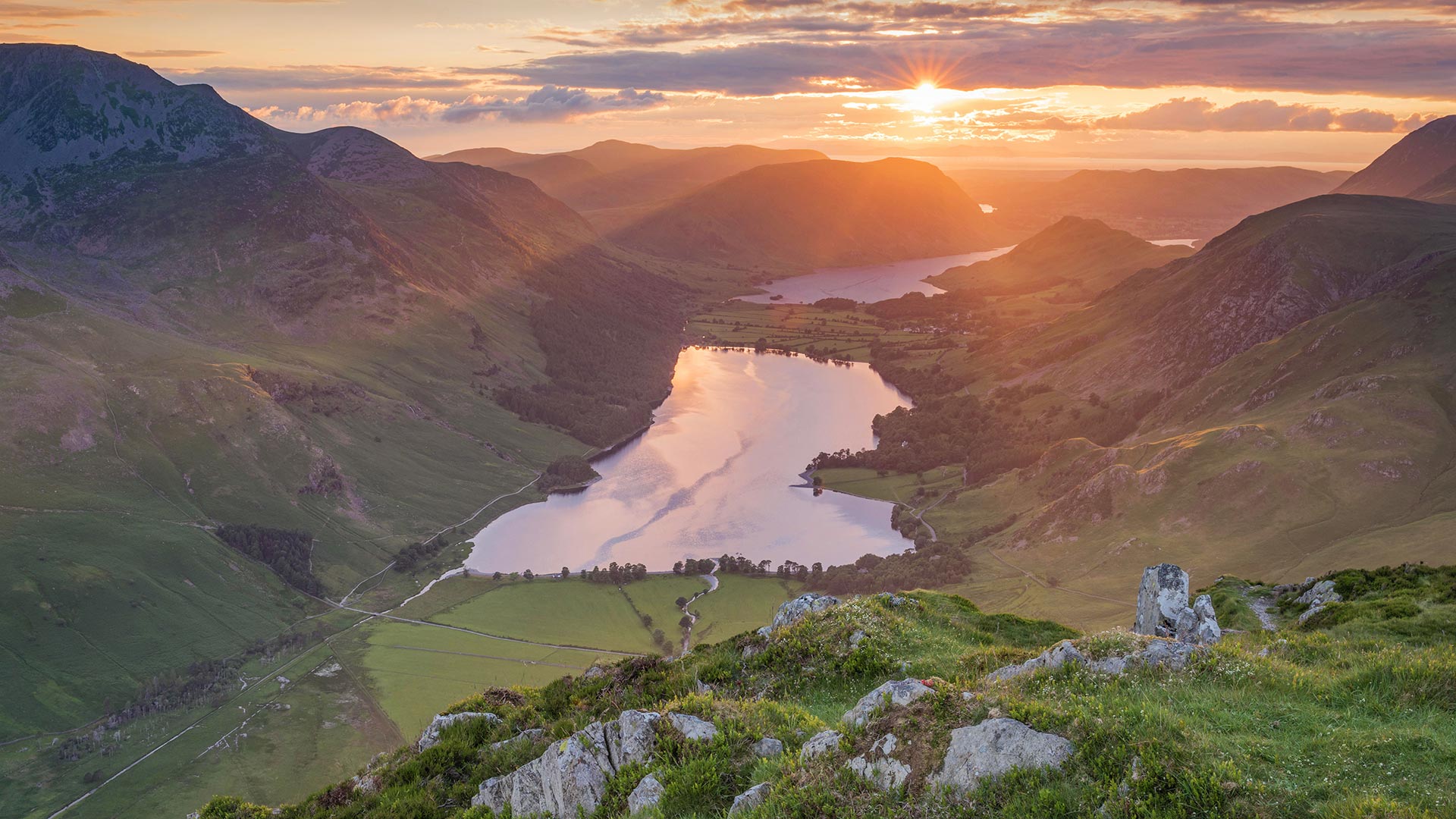马哈拉施特拉邦的Varandha Ghat,印度 Varandha Ghat in Maharashtra, India (© AmitRane1975/iStock/Getty Images Plus)
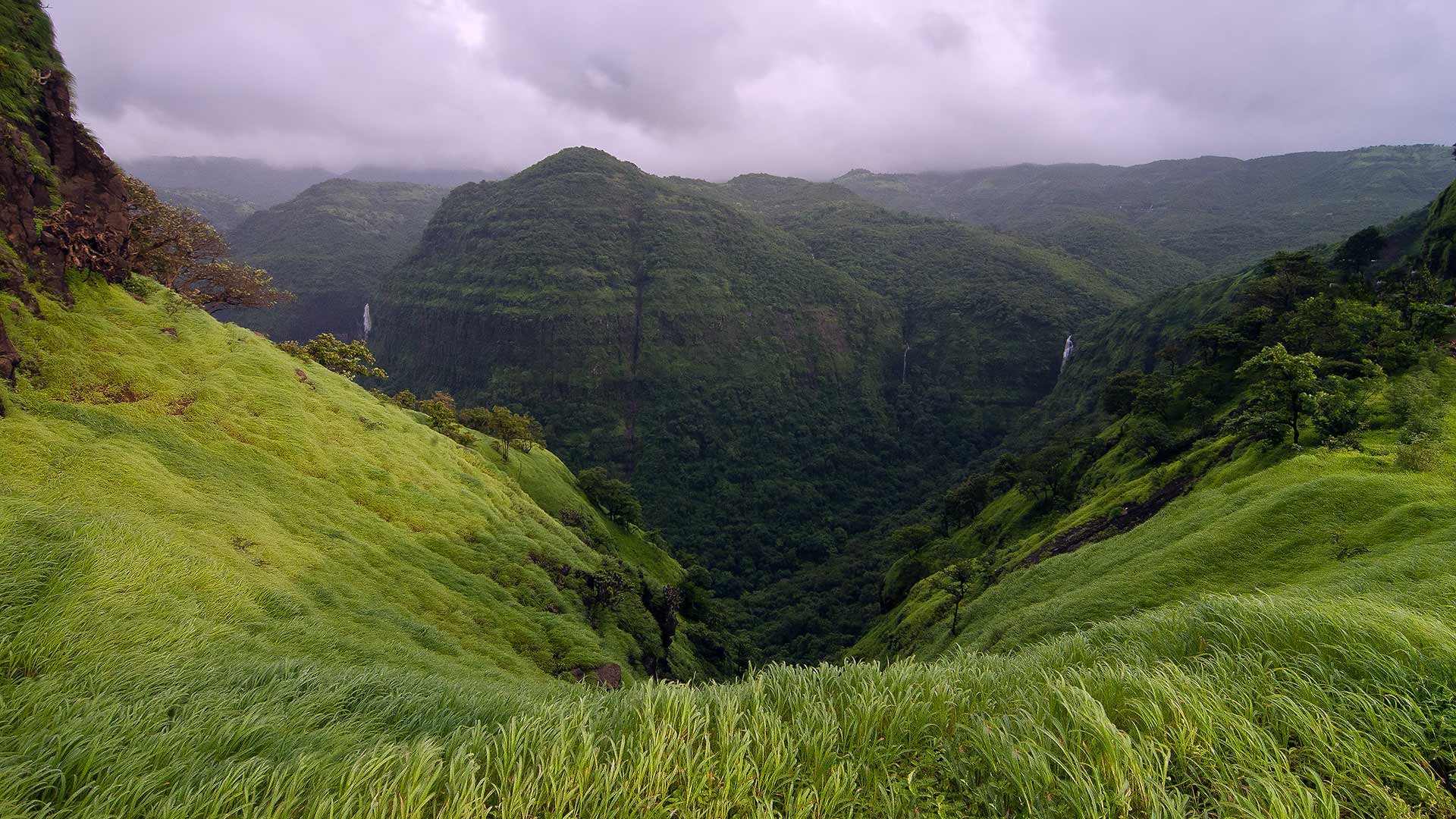
马哈拉施特拉邦的Varandha Ghat,印度 Varandha Ghat in Maharashtra, India (© AmitRane1975/iStock/Getty Images Plus)
50 shades of green…
Foggy roads and high altitude - do these send an adrenaline rush through your body? Well, then head to Varandha Ghat to experience some more. A mountain passage located between NH4 and Konkan in Maharashtra, India, is an ideal place for nature lovers and adrenaline junkies. The lush green mountains, scenic waterfalls, and lakes make this place a good tourist attraction. The best time to visit is monsoon season.
50种绿色…
雾天的道路和高海拔-这些会让你的身体产生肾上腺素吗?好吧,那就去瓦兰达高特体验一下吧。位于印度马哈拉施特拉邦NH4和孔坎之间的一条山路,是热爱大自然和肾上腺素上瘾者的理想去处。郁郁葱葱的青山、风景秀丽的瀑布和湖泊使这个地方成为一个很好的旅游景点。游览的最佳时间是季风季节。
2015年4月4日摄于Tear Drop Arch附近的月全食,犹他州纪念碑谷 The total lunar eclipse of April 4, 2015, taken from near Tear Drop Arch, in western Monument Valley, Utah (© Alan Dyer/Alamy)
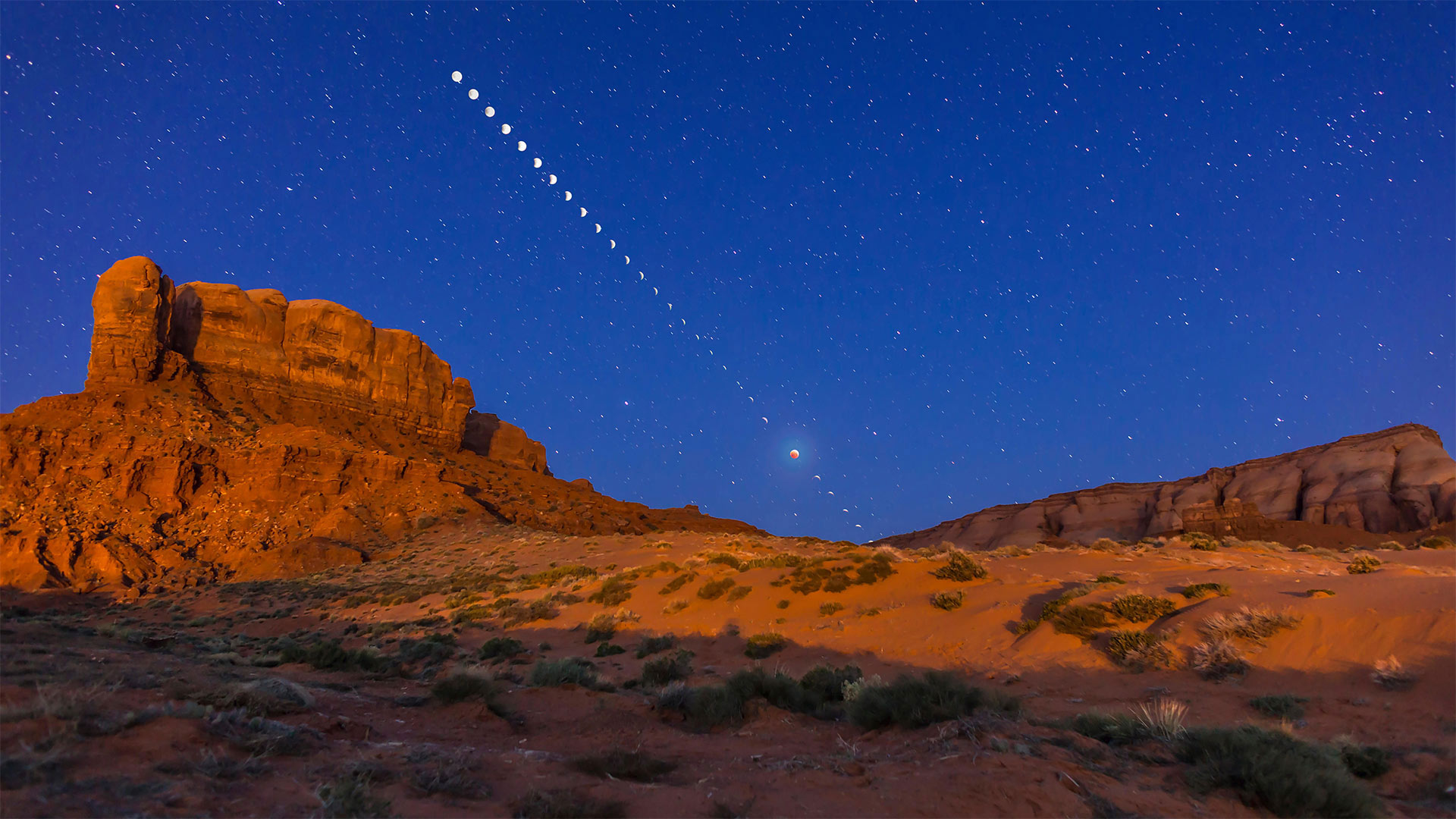
2015年4月4日摄于Tear Drop Arch附近的月全食,犹他州纪念碑谷 The total lunar eclipse of April 4, 2015, taken from near Tear Drop Arch, in western Monument Valley, Utah (© Alan Dyer/Alamy)
Behold the blood moon
We've heard the phrase 'many moons,' but never took it this literally. We're looking at 28 merged photos of our one and only moon over Utah's Monument Valley: 26 snapshots of its partial phases, plus two layered exposures of the eclipsing moon at center.
If the weather's agreeable tonight, folks in the US and many other parts of the world are in for a total 14-minute eclipse of the full moon similar to this one from 2015. The lunar eclipse is sometimes called a blood moon for the crimson shadow Earth casts on the lunar surface, and tonight's show carries a little extra gravity: The eclipse will occur as the moon takes its closest pass to Earth this year, making it appear large in the sky and giving it the ominous title of Super Blood Moon.
看血月
我们听过“许多月亮”这句话,但从来没有这样的字面意思。我们正在看28张合并后的照片,这是犹他州纪念碑谷上空我们唯一的一个月亮:26张部分相位的快照,加上两层日食月亮的中心曝光。
如果今晚天气宜人,美国和世界其他许多地方的人们将迎来一次14分钟的满月全食,与2015年的这次月食相似。月食有时被称为血月,因为地球在月球表面投下了深红色的阴影,今晚的节目还有一点额外的引力:今年月亮离地球最近的时候会发生月食,使它在天空中显得很大,并给它一个不祥的称号“超级血月”。
由丹麦建筑师Niels Povlsgaard和JohanGjødes设计的无限桥,丹麦奥胡斯 The Infinite Bridge, designed by Danish architects Niels Povlsgaard and Johan Gjødes, in Aarhus, Denmark (© Kosmaj/Shutterstock)
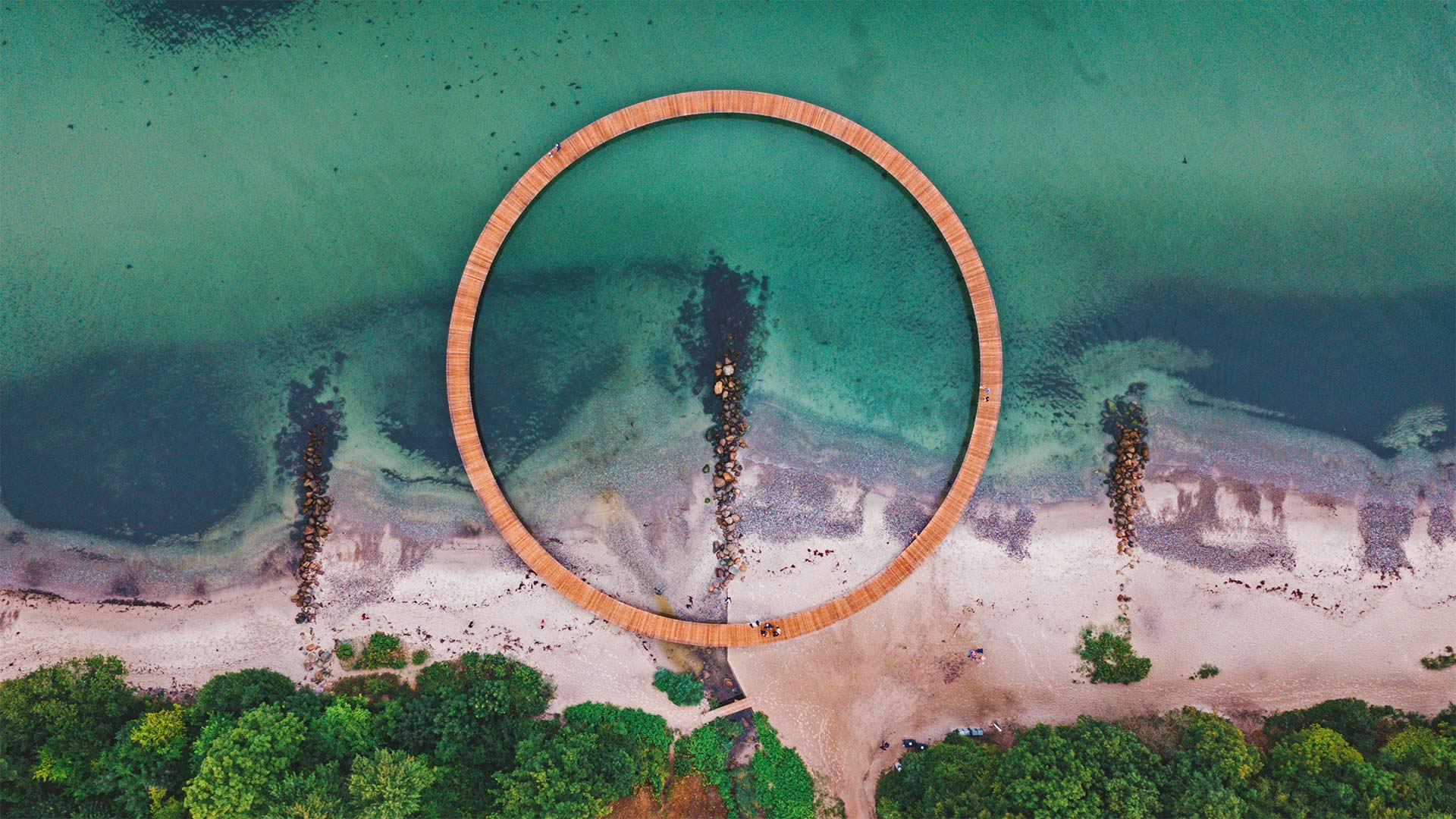
由丹麦建筑师Niels Povlsgaard和JohanGjødes设计的无限桥,丹麦奥胡斯 The Infinite Bridge, designed by Danish architects Niels Povlsgaard and Johan Gjødes, in Aarhus, Denmark (© Kosmaj/Shutterstock)
A bridge come full circle
If residents of Aarhus, Denmark's second-largest city, feel like they're going around in circles, then it might have something to do with this wooden walkway. The Infinite Bridge, or 'Den Uendelige Bro' to locals, spans about 200 feet in diameter and forms a perfect circle overlapping the sand and sea, offering sweeping views across Aarhus Bay and along the tree-lined beach. Designed by Danish architects Niels Povlsgaard and Johan Gjødes, it was originally constructed as a temporary display in 2015 for the city's Sculpture by the Sea exhibition. But the never-ending pier proved so popular with visitors, it has since become a permanent fixture during the spring and summer months.
一座桥绕了一圈
如果丹麦第二大城市奥胡斯的居民觉得自己在兜圈子,那么这可能与这条木制走道有关。这座名为“Den Uendelige Bro”的桥直径约200英尺,形成一个完美的圆形,覆盖着沙滩和大海,可以俯瞰奥胡斯湾和绿树成荫的海滩。由丹麦建筑师尼尔斯·波夫尔斯加德(Niels Povlsgaard)和约翰·吉恩(Johan Gj)设计ø它最初是在2015年为该市的“海边雕塑展”临时搭建的。但事实证明,这个永无止境的码头非常受游客欢迎,因此在春夏两个月里,它就成了永久性的固定设施。
纽约公共图书馆总部翻新后的玫瑰主阅览室,纽约市 The renovated Rose Main Reading Room inside the New York Public Library Main Branch, New York City (© Sascha Kilmer/Getty Images)

纽约公共图书馆总部翻新后的玫瑰主阅览室,纽约市 The renovated Rose Main Reading Room inside the New York Public Library Main Branch, New York City (© Sascha Kilmer/Getty Images)
So many books, so little time
May 23, 2021 marks the 110th anniversary of the opening the of the New York Public Library's Main Branch (now known as The Stephen A. Schwarzman Building). Back just before the turn of the 20th century, a group of New York City businessmen decided that if their hometown was ever going to compete with Paris and London as a center of urban culture, then it needed a great library.
It took almost two decades and a lot of brainpower and money to create the architectural masterpiece that stands today on New York's 42nd Street. On the day it opened to the public, 30,000 to 50,000 people streamed through its doors to take in the architecture and gaze at the one million books on display. The first book request was filed at 9:08 AM and was delivered to the reader 6 minutes later through the library's rapid delivery system. Since then, it's become part of the very fabric of New York and has been featured in movies from 'Breakfast at Tiffany's' to 'Ghostbusters' to 'Spiderman.'
Today, we turn our gaze to the Beaux-Arts delight that is the Main Branch's Rose Reading Room. It is truly one of the city's great public spaces, a lavish hall where one can come to escape the bustle of the city streets and the honking of taxis. This room underwent an extensive renovation after one of the gilded rosettes crashed to the floor in May 2014. Now it's all spiffed up and in perfect form for its anniversary celebration.
这么多的书,这么少的时间
2021年5月23日是纽约公共图书馆主分馆(现称斯蒂芬A。施瓦茨曼大厦)。早在20世纪之交之前,一群纽约市的商人就决定,如果他们的家乡要与巴黎和伦敦作为城市文化中心竞争,那么它就需要一个伟大的图书馆。
它花了将近二十年的时间,用了大量的脑力和金钱,才创造出今天矗立在纽约42街的建筑杰作。在它向公众开放的那天,三万到五万人从它的门前涌进,参观这座建筑,观看展出的一百万本书。第一本书是在上午9点08分提出的,6分钟后通过图书馆的快速投递系统投递给读者。从那时起,它就成为了纽约的一部分,并出现在从《蒂凡尼早餐》到《鬼怪》再到《蜘蛛侠》的电影中
今天,我们将目光转向博克斯艺术的喜悦,这是主要分支的玫瑰阅览室。这真的是一个城市的伟大的公共空间,一个奢华的大厅,人们可以在这里逃离繁忙的城市街道和出租车鸣笛。2014年5月,一个镀金的花环掉在地上,这间屋子经过了一次大范围的翻新。现在,它已经装饰得整整齐齐,为它的周年庆典提供了完美的形式。
由中世纪的城墙包围着的市镇,西班牙滨海托萨 The medieval walled town in Tossa de Mar, Catalonia, Spain (© dleiva/Alamy)
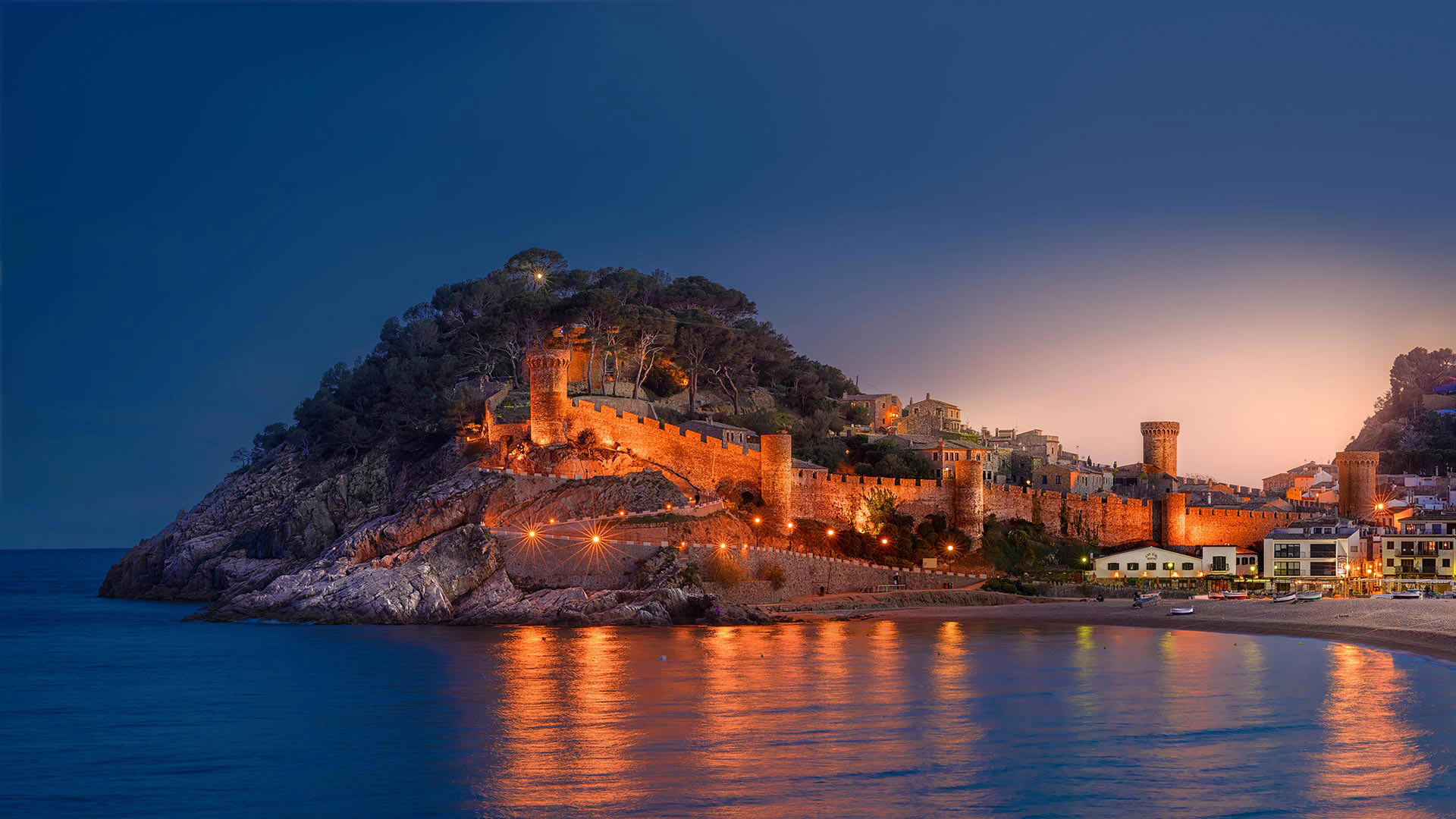
由中世纪的城墙包围着的市镇,西班牙滨海托萨 The medieval walled town in Tossa de Mar, Catalonia, Spain (© dleiva/Alamy)
Blue paradise on the Costa Brava
On Spain's Costa Brava, about 45 miles north of Barcelona, lies a perfectly preserved medieval town just beyond the enceinte (stone wall) you see curving up the hillside. La Vila Vella (The Old Town) blends with the more modern, larger city of Tossa de Mar. Here, the 21st century melds beautifully with the 14th.
Modern hotels are just out of the camera's viewfinder. Visitors can spend their days sunbathing on the beach, diving in the sea or strolling La Vila Vella's narrow, winding streets past centuries-old architecture. Just beyond the defensive walls is the deep blue sea. It was this view that inspired French painter Marc Chagall to nickname Tossa de Mar 'blue paradise.' In fact, Tossa de Mar has long been a haven for artists. Actress Ava Gardner loved the town so much while making two movies there in the '50s that the town has erected a statue in her memory.
布拉瓦海岸蓝色天堂
在西班牙的布拉瓦海岸,巴塞罗那以北大约45英里,坐落着一个保存完好的中世纪城镇,就在你看到的蜿蜒的山坡上。拉维拉维拉(老城区)与更现代化、更大的城市托萨德马尔融合在一起。在这里,21世纪与14世纪完美融合。
现代化的旅馆就在照相机的取景器外。游客可以在沙滩上晒日光浴,在海里潜水,或者漫步在拉维拉维拉的狭窄蜿蜒的街道上,这是一座古老的建筑。就在防御墙的后面是深蓝色的大海。正是这种观点启发了法国画家马克·夏加尔给托萨德马尔起了一个绰号“蓝色天堂”。事实上,托萨德马尔长期以来一直是艺术家的天堂。女演员艾娃·加德纳(Ava Gardner)在50年代拍摄两部电影时非常喜欢这个小镇,以至于小镇在她的记忆中竖起了一座雕像。
巴特米尔湖上的落日 ,英格兰湖区 (© Stewart Smith/Alamy)
飘落的杜鹃花瓣铺在Grassy Ridge Bald山的小径上,北卡罗莱纳州皮斯加国家森林 Fallen rhododendron petals line a trail on Grassy Ridge Bald, Pisgah National Forest, North Carolina (© aheflin/Getty Images Plus)
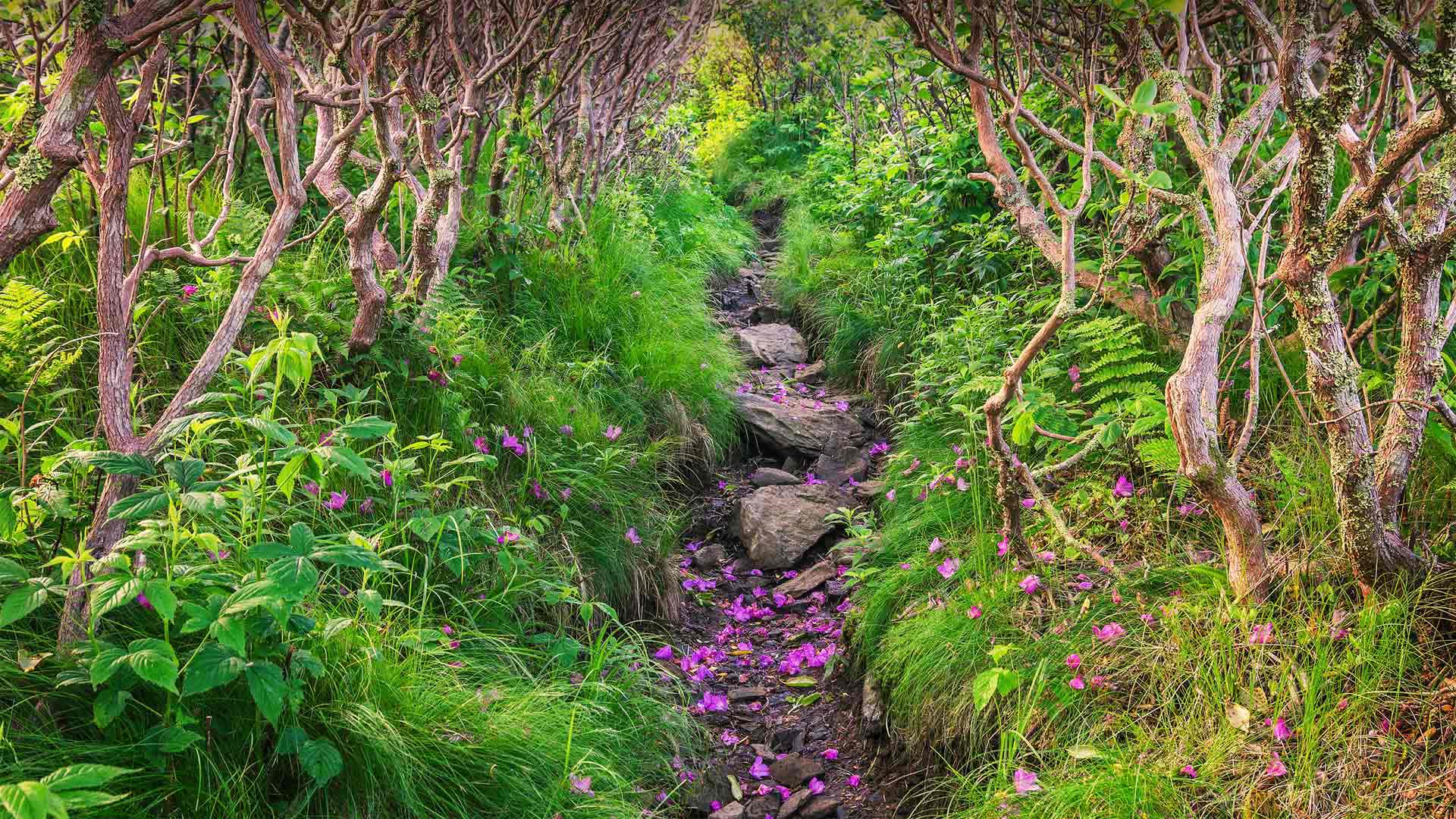
飘落的杜鹃花瓣铺在Grassy Ridge Bald山的小径上,北卡罗莱纳州皮斯加国家森林 Fallen rhododendron petals line a trail on Grassy Ridge Bald, Pisgah National Forest, North Carolina (© aheflin/Getty Images Plus)
A path lain with petals
Pisgah National Forest, in western North Carolina, is primarily a hardwood forest boasting 500,000 acres of mountainous peaks and cascading waterfalls that attract hikers, anglers, mountain bikers, and more. But from mid-May to mid-June, the crowds flock here to hike trails that lead to incredible views: acres of native Catawba rhododendrons in full blossom.
The trail pictured here leads to Grassy Ridge Bald and to the 'rhodies.' Grassy Ridge Bald is one of several treeless, grassy ridges found in Pisgah's Roan Mountains, which straddle the Tennessee and North Carolina border. The area boasts not just Catawba rhododendrons, but also huge swaths of orange flame azaleas and wildflowers. If you're lucky, you may even spot the rare Gray's Lily, which was first discovered on Roan Mountain.
铺满花瓣的小路
皮斯加国家森林位于北卡罗来纳州西部,主要是一片硬木森林,拥有50万英亩的山峰和瀑布,吸引着远足者、钓鱼者、山地自行车手等等。但从5月中旬到6月中旬,人们蜂拥到这里徒步旅行,这里可以看到令人难以置信的景色:成片的当地卡塔巴杜鹃花盛开。
图中的这条小径通向“草岭秃顶”和“罗地亚”。草岭秃顶是在横跨田纳西州和北卡罗来纳州边界的皮斯加罗恩山脉发现的几种无树、长满草的山脊之一。这个地区不仅拥有卡塔巴杜鹃,还有大片的橙色火焰杜鹃花和野花。如果你幸运的话,你甚至可以发现罕见的灰百合,这是最早在罗安山发现的。
西班牙马拉加蓬皮杜中心 Centre Pompidou Málaga in Málaga, Spain (© Wim Wiskerke/Alamy)
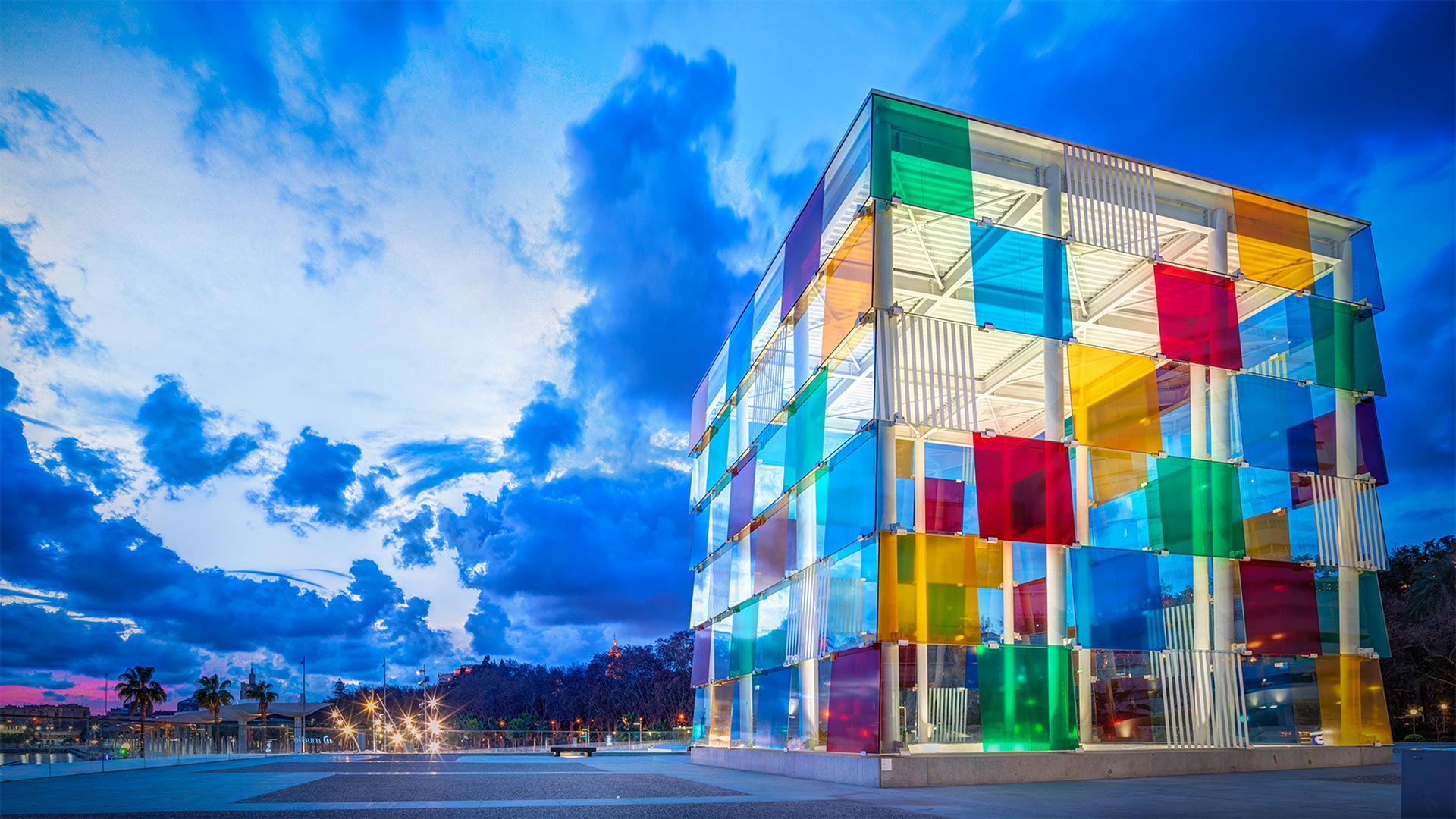
西班牙马拉加蓬皮杜中心 Centre Pompidou Málaga in Málaga, Spain (© Wim Wiskerke/Alamy)
International Museum Day
On International Museum Day, we're looking at the Centre Pompidou Málaga in Spain, an offshoot of the modern art museum in Paris. This location was introduced in 2015 as a pop-up branch—a temporary, underground space for exhibitions and multi-disciplinary experiences as well as workshops dedicated to younger audiences. Originally scheduled for a 5-year run, it was extended until 2025. The piece we see here, 'El Cubo,' created by French artist Daniel Buren, is the only part of the museum that's visible above ground. The glass cube functions as a multicolored skylight, its panels projecting tinted light into the subterranean museum's courtyard below.
International Museum Day began in 1977, with participating museums, galleries, and similar institutions offering free or reduced admission, as well as programs to highlight the work they do. In 2020, the format was adapted to focus on virtual activities, and this year will offer a mix of online, hybrid, and in-person events. As museums around the world begin to re-open their doors, this year's theme is 'The Future of Museums: Recover and Reimagine.'
国际博物馆日
在国际博物馆日,我们看到的是西班牙拉加蓬皮杜市中心,巴黎现代艺术博物馆的一个分支。2015年,这一位置作为一个弹出式分支引入,是一个临时地下空间,用于展览和多学科体验,以及专门为年轻观众举办的研讨会。原计划运行5年,延长至2025年。我们在这里看到的是法国艺术家丹尼尔·布伦(Daniel Buren)创作的“El Cubo”,这是博物馆中唯一能在地面上看到的部分。玻璃立方体的功能就像一个五颜六色的天窗,它的面板将有色光线投射到地下博物馆的庭院下面。
国际博物馆日始于1977年,参加活动的博物馆、美术馆和类似机构提供免费或减少门票,以及突出他们所做工作的项目。2020年,这种形式被调整为以虚拟活动为重点,今年将提供在线、混合和面对面的活动。随着世界各地的博物馆开始重新开放,今年的主题是“博物馆的未来:复原和重新想象”
奥勒松,挪威 Ålesund, Norway (© AWL Images/Offset by Shutterstock)
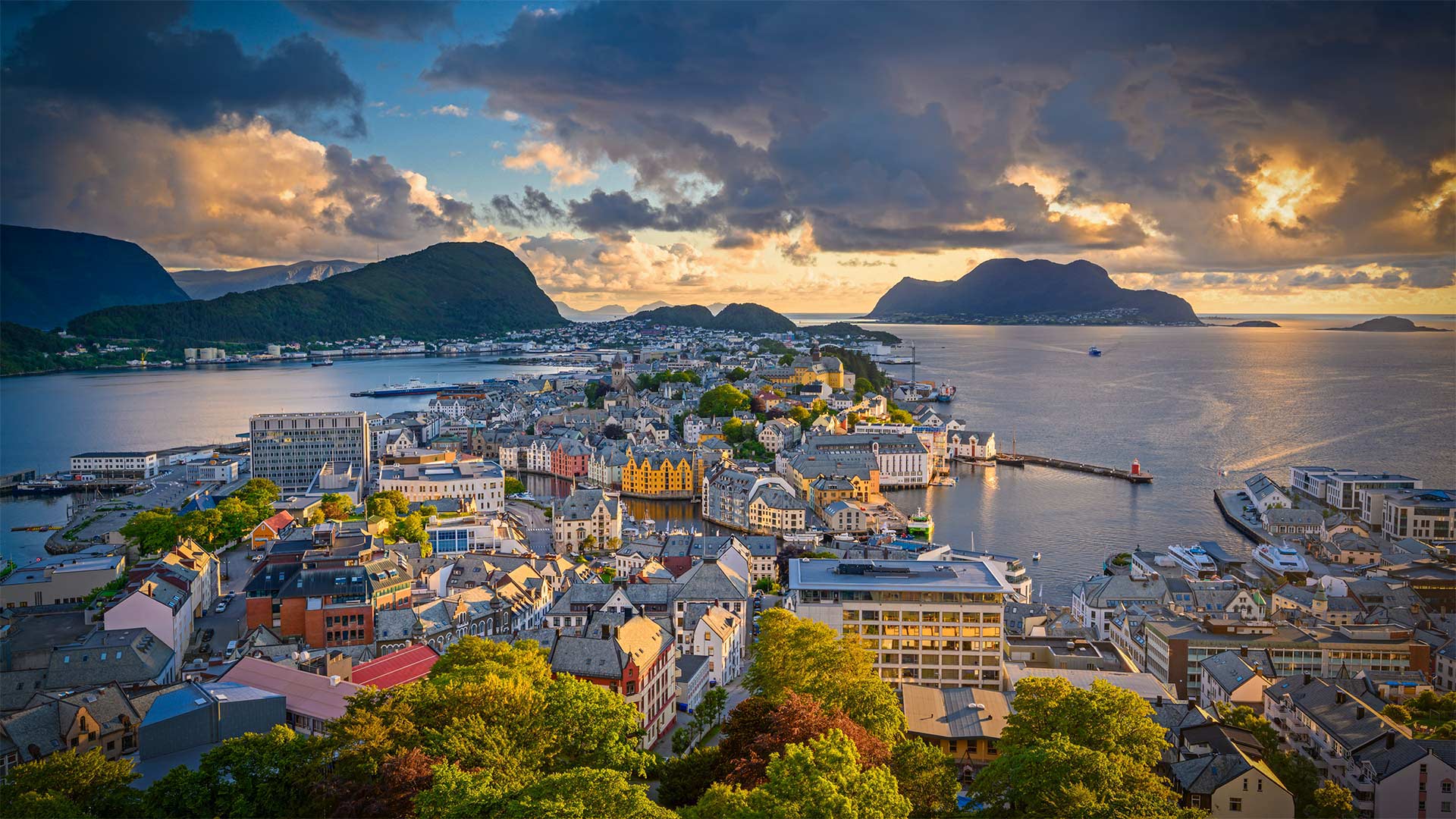
奥勒松,挪威 Ålesund, Norway (© AWL Images/Offset by Shutterstock)
Happy Syttende Mai!
If you have Norwegian roots, May 17, aka Syttende Mai, is a day to celebrate. On this day in 1814, the Constitution of Norway was signed, declaring Norway an independent kingdom. Today we honor this stunning country by flying over the town of Ålesund, nestled amid the mountains and fjords in the western part of the country. This seaport stretches across several islands linked by bridges and is known for its charming Art Nouveau architecture. In ordinary years, Ålesund draws hordes of tourists and serves as a gateway for visitors to explore the bird island of Runde as well as Geirangerfjord, considered one of Norway's most beautiful fjords.
祝你快乐!
如果你有挪威的根,5月17日,又名Syttende Mai,是一个值得庆祝的日子。1814年的今天,挪威宪法签署,宣布挪威为独立王国。今天,我们飞过这个令人惊叹的国家Å莱松,坐落在该国西部的群山和峡湾之中。这个海港横跨几个岛屿,由桥梁连接,以其迷人的新艺术主义建筑而闻名。平日里,Å莱松德吸引了大批游客,成为游客探索伦德鸟岛以及被认为是挪威最美丽峡湾之一的盖兰热峡湾(Geirangerfjord)的门户。
鸟瞰瓜塔佩巨岩,哥伦比亚瓜塔佩 Aerial view of El Peñón de Guatapé, Guatapé, Antioquia, Colombia (© Amazing Aerial Agency/Offset by Shutterstock)
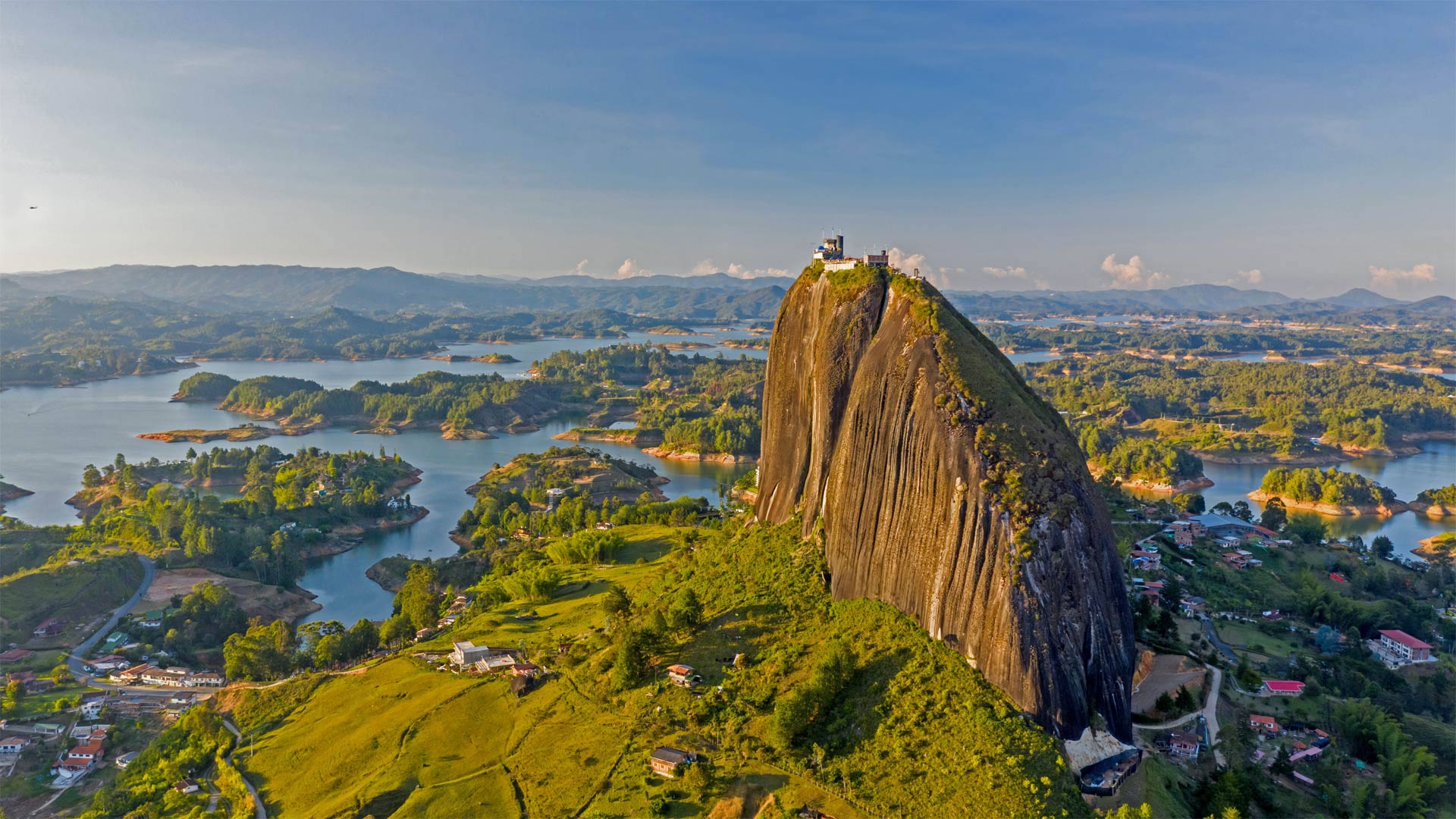
鸟瞰瓜塔佩巨岩,哥伦比亚瓜塔佩 Aerial view of El Peñón de Guatapé, Guatapé, Antioquia, Colombia (© Amazing Aerial Agency/Offset by Shutterstock)
A magnificent monolith
Towering more than 650 feet, El Peñón de Guatapé (The Rock of Guatapé) is an inselberg, which is geologist-speak for a stone monolith that stands alone amid relatively flat surroundings. This huge rock is found in northwest Colombia, a region once inhabited by indigenous Tahamí people, who are said to have worshipped El Peñón, as many locals now call it. Probably because it's so smooth, no one is known to have climbed the rock until 1954, when a small group of friends scaled it by wedging a series of boards into a vertical crack. It took them five days to reach the top.
These days El Peñón is considerably easier to climb, but it'll still make you work for that view at the top. Into the same crack the climbers used back in '54, a masonry staircase now makes several switchbacks all the way to the summit. Each of the 740 stairs is numbered, so you can be reminded with each step just how many more remain before you arrive at the viewing platform up top.
宏伟的巨石
高达650英尺,瓜塔佩岛 (瓜塔佩之岩) 是一个孤山,这是地质学家所说的在相对平坦的环境中独立存在的一块石头。这块巨石发现于哥伦比亚西北部,该地区曾是土著塔哈姆人的聚居地í 据说崇拜艾尔佩的人ñón、 正如许多当地人现在所说。可能是因为它太光滑了,直到1954年,一小群朋友用楔子把一系列木板塞进一条垂直的裂缝里,才知道有人爬上过这块岩石。他们花了五天时间才到达顶峰。
这些天埃尔佩ñón是相当容易攀登,但它仍然会使你在顶部的看法工作。在54年登山者使用过的同一条裂缝中,一个石质楼梯现在可以在通往山顶的路上进行多次转换。740个楼梯中的每一个都有编号,因此在您到达顶部的观景台之前,每一步都可以提醒您还有多少楼梯。
